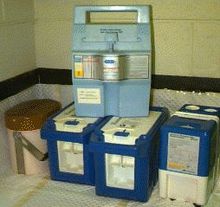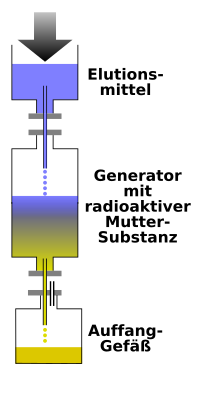Technetium 99m generator
A technetium-99m generator is a radionuclide generator used to extract the metastable isotope technetium-99m from a source containing decaying molybdenum-99 . Technetium-99m is required for a wide variety of applications in nuclear medicine .
99 Mo has a half-life of 66 hours and can be brought over greater distances to hospitals and practices, where the decay product technetium-99m (with the very unfavorable half-life of only 6 hours for transport) is extracted. In nuclear medicine, the short half-life, the favorable radiation quality ( gamma emitter ) and the favorable radiation energy (140.1 and 140.6 keV) of the technetium-99m are very much appreciated.
mechanism
The half-life of the mother nuclide 99 Mo is 66 hours, much longer than that of the daughter nuclide 99m Tc, which is 6 hours. 50% of the equilibrium activity is reached within one half-life of the daughter nuclide, 75% within two half-lives of the daughter nuclide. Therefore, the removal of the daughter nuclide ( elution process ) from the generator (“milking” the generator) should be carried out approximately every 6–12 hours.
Most commercial 99 Mo / 99m Tc generators use 99m Tc chromatography columns in which 99 Mo is deposited on acidic aluminum oxide. If a normal saline solution is pushed through the columns with immobilized 99 Mo and soluble 99m Tc, a saline solution is created that contains 99m Tc, to which the pharmaceuticals specific for the respective organ are then added in the appropriate concentration. The isotope can also be used without pharmaceutical labeling for certain purposes that require pure 99m Tc as the primary radiopharmaceutical (e.g. thyroid scintigraphy ).
The useful life of a 99 Mo / 99m Tc generator is around three half-lives of molybdenum, i.e. around one week. After that the content of 99 Mo is too low. Thus, a clinic or practice for nuclear medicine buys at least one such generator per week or several in staggered form.
99 Mo can be generated by neutron activation (nγ reaction) of 98 Mo in a reactor with a high neutron flux. Most of the methods used use a 235 U target. Irradiating the target with neutrons produces 99 Mo as a fission product.
Decay process
The decay process occurring in a technetium generator can be described as follows:
Here, the 99 Mo decays into excited states of the 99 Tc with a half-life of 66.02 hours . Around 14% of the 99 Mo decay by means of beta-minus decay into the ground state of 99 Tc and around 86% into the metastable state of 99m Tc. This in turn has an excitation energy of 143 keV and decays into the unstable ground state of 99 Tc through gamma emission and internal conversion with a half-life of 6.02 hours .
See also
literature
- H. Krieger: Fundamentals of radiation physics and radiation protection BG Teubner Verlag, 2007, ISBN 3-519-00487-9
Individual evidence
- ↑ Technical information Elumatic III Technetium-99m-Generator. (PDF; 216 kB) CBI Medical Products Vertriebs GmbH, April 15, 2010, accessed on May 13, 2010 (German).
- ↑ Snelgrove JL et al., DEVELOPMENT AND PROCESSING OF LEU TARGETS FOR MO-99 PRODUCTION-OVERVIEW OF THE ANL PROGRAM , International Meeting on Reduced Enrichment for Research and Test Reactors 1995 (PDF; 50 kB)
Web links
- Brookhaven National Laboratory website for the history of the technetium generator. (English)
- chemie-master.de - Technetium-99m-Generator: Functional model and description




